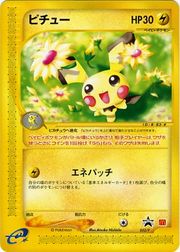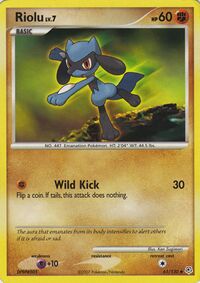From Bulbapedia, the community-driven Pokémon encyclopedia.
Pichu
ピチュー Pichu
|

|
|
|
|
| Expansion
|
Sample Set
|
| Rarity
|

|
| English card no.
|
083/093
|
|
|
| For more information on this Pokémon's species, see Pichu.
|
|
Pichu (Japanese: ピチュー Pichu) is a Lightning-type Baby Pokémon card. It was first released as part of the Sample Set, later released in the English Expedition Base Set.
Card text
Sample Set print
|
|
If this Baby Pokémon is your Active Pokémon and your opponent announces an attack, your opponent flips a coin (before doing anything else). If tails, your opponent's turn ends.
|
|

|
Power Patch
エネパッチ
|
|
|
| Choose 1 Basic Energy card attached to 1 of your Pokémon and attach it to another 1 of your Pokémon.
|
|
Expedition Base Set print
|
|
If your Active Pokémon is a Baby Pokémon and your opponent announces an attack, your opponent flips a coin (before doing anything else). If tails, your opponent's turn ends.
|
|

|
Energy Patch
エネパッチ
|
|
|
| Take a basic Energy card attached to 1 of your Pokémon and attach it to another of your Pokémon.
|
|
e-Reader data
This card has four prints. The card ID of the Holofoil Expedition Base Set print is B-83. The card ID of the standard Non Holofoil Expedition Base Set print and the P Promotional print is B-83-#. A Sample version of the Non Holofoil Expedition Base Set print has the card ID M-83-#. On the Non Holofoil Expedition Base Set prints and the P Promotional print, the short strip contains Pokédex information, a brief card summary, and information on the content of the long strip. The species, height, and weight are present on the Holofoil Expedition Base Set print.
Pokédex data
| Pichu - Tiny Mouse Pokémon
|
| No.
|
Height
|
Weight
|
| 172
|
1'0" (0.3 m)
|
4 lbs. (2.0 kg)
|
| Pokédex entry
|
| It is unskilled at storing electric power. Any kind of shock causes it to discharge energy spontaneously.
|
| でんきを ためこむのが へた。 なんらかの ショックを うけると すぐに ほうでん してしまう。
|
Mini-game
The long strip contains data for the Hold Down Hoppip mini-game. Hoppip from Expedition Base Set is also required to play it.
Release information
This card was included in the English Expedition Base Set, first released in the Japanese Base Expansion Pack, with artwork by Atsuko Nishida as both a Cosmos Holofoil card and Non Holofoil card. It was later reprinted in Japan with new artwork by the same artist as part of a McDonald's promotion that ran between May 25 and June 16, 2002.
In order to promote the e-Reader outside Japan, Nintendo had Media Factory produce the Sample Set, a 10 card collection from the upcoming Expedition Base Set in English used to demonstrate the Dot Code technology at a media pre-launch party at the New York Pokémon Center in August 2002. This card, as well as the other 9, are printed with a Japanese card back, and have Sample in the bottom right corner where the expansion symbol would usually be. Approximately 50 sets were printed for use at the event, and were never intended for distribution. Cards that did not make it into circulation were apparently destroyed.
At the E3 Convention in 2002, 4 months before Expedition Base Set's release, booster packs were given to attendees to promote the upcoming launch of the e-Reader. These booster packs contained a Game & Watch "Manhole" card, a Kirby e-Card, and early prints of the non-holo Pichu and Hoppip. The two Pokémon cards from this set featured the new (at the time) Japanese back and had slightly rearranged text positioning, unlike the final release which used the same English back as earlier sets had used.
Prior to the launch of both the Expedition Base Set and the Game Boy Advance e-Reader itself, slightly thicker-than-usual, glossy versions of the non-holo Pichu, Hoppip, and "Manhole" card were used to demonstrate the e-Reader's functionality. Unlike the prints given out at E3, these prints have an English back. These three cards were hole-punched so that they could be attached to promotional kiosks by having a cable looped through them; this was done to prevent loss or theft while allowing enough flexibility for the card to be swiped through the device.
The vast majority of Japanese Base Expansion Pack cards have a 1st Edition stamp, however some were released in unlimited format. It is not known how the unlimited cards were distributed, but it's thought that they came from a special edition of Pokémon-e Starter Deck box which was distributed to 50 winners of a coloring contest held in Japan in 2002.
Gallery
Trivia
Origin
This card's e-Reader Pokédex entry comes from Pokémon Crystal.





